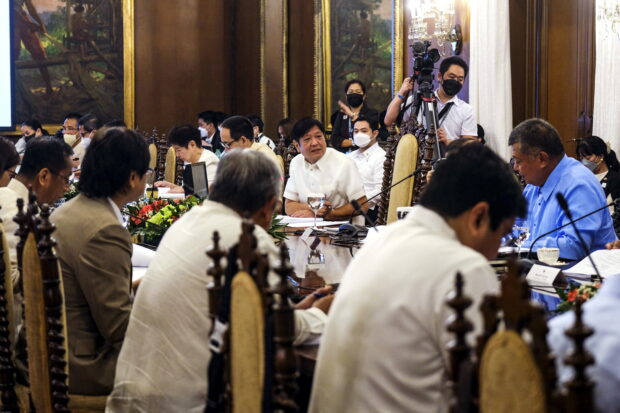Marcos’ first year in office: The past and present in the official family

MANILA, Philippines — The second Marcos presidency was born under the shadow of the first: a public expectation of excellence in Cabinet appointments. But it was also born in a different era: a post-pandemic world, in which economic rehabilitation was foremost in both global and domestic observers’ minds. Finally, there was also the blunt reality that as historic as the victory of President Ferdinan Marcos Jr. was, every administration is a coalition, and every faction expects a role.
All this helps to explain what preceded Marcos’ oath-taking: the jockeying for position, and clumsy demands for a share of the spoils of victory; the echoes of the past, in the president-elect’s choices for appointments; and the combination of self-assurance in this, the third restoration regime of our republic, and improvisation due to the short amount of time between a president-elect’s proclamation and the actual inauguration.
From this coalition, there came crude, social media-driven efforts to float potential Cabinet appointments to preempt, or worse, hem in, the incoming administration. Then there was the unexpected, because naïve, demand by Vice President-elect Sara Duterte to be given the defense portfolio, which the president-elect, in his first demonstration of leadership, had to forcefully but diplomatically reject (she was given, and accepted, the thankless job of secretary of education instead).
Echoes of the past lay in the selection of familiar names from the first Marcos regime: either second-generation legacy appointees such as Conrado Estrella III, Susan Ople, Toni Yulo-Loyzaga, or actual veterans, such as Juan Ponce Enrile, who was returning to serve in a Marcos Cabinet 40 years after having served in the first: making him the oldest Cabinet officer in our history, but also a throwback to Marcos Sr.’s appointing Jose Yulo (grandfather of Yulo-Loyzaga) to the justice portfolio 30 years after he first held the post during the Commonwealth.
Credible economic team
Marcos’ primary, almost exclusive, focus was on recruiting a credible economic team. His being able to do so went far to dispel any anxiety over the short-term prospects of the administration. But it meant that when he took office, there were gaps in his official family. Marcos lacked a secretary of foreign affairs. The post was filled only shortly after he assumed office, which left the president to his own devices on inauguration day, his first test of diplomatic skill considering the high-profile delegations sent by the United States, China, Japan, and Australia.
In retrospect, this should have served as an indication of where the new president was most confident in his own skills, foreign affairs, as shown by the choice of a bland figure, career diplomat Enrique Manalo, to be a nonthreatening choice.
He also started with only an officer in charge (OIC) designated for the Department of National Defense (DND), which was explained away as a necessity because of a legal impediment to his choice to assume the portfolio immediately. It was here, as it turned out, that the president seemed to find the question of appointments the most problematic. Months were spent dealing with the unintended fallout of having a fixed term for the AFP chief of staff. It entailed shuffling generals and OICs in DND. The health department, too, remained in limbo for nearly a full year.
The only surprises lay in the choice of the new president’s senatorial chief of staff to be executive secretary, when he lacked the experience normally expected of the job. In turn, Marcos’ choice for communications and national security adviser could only be understood in terms of factions — in this instance, those associated with the new executive secretary.
This, in turn, would be quickly evicted in what was widely understood to be a housecleaning effort by the first lady. Something she herself denied: while the president said she was a great organizer, he eventually said he consulted her on legal, and not administrative, matters.
Early on, the president also undertook a reorganization of his office, undoing some of the changes made by his two immediate predecessors, such as the abolition of the position of Cabinet secretary and subordination of the Presidential Management Staff to the executive secretary. By reestablishing the position of presidential adviser on military and police affairs and placing it under the special assistant to the president, he reverted to an earlier model of management.
Cabinet mix
In his first year, Marcos’ Cabinet could be described as being a mix of pragmatic politicians such as Benhur Abalos and Jesus Crispin Remulla (including a subset of local politicians: Christina Frasco, Zenaida Angping), technocrats, legacy appointees harking back to the era of his father, and placeholders keeping positions warm until the expiration of the ban on defeated candidates being appointed.
Of course, there were also removals, resignations, and reinforcements: Erwin Tulfo failed to withstand congressional scrutiny; Zenaida Angping was brought down by the alleged antics of her husband; Paul Soriano was brought in to burnish the presidential image. All these resulted in untidy backbiting and rumor-mongering within the chattering classes of the president’s own coalition to explain his choices or lack of them.
Only when the one-year ban on appointing defeated candidates expired, and Gilberto Teodoro Jr. and Ted Herbosa were named to the defense and health departments, can the president be said to have truly completed the task of forming his Cabinet.
The past year demonstrated the hallmarks of the Marcos restoration: nods to the past, self-assurance in foreign affairs, conservatism in domestic political management, but a willingness to fire rather than let problems fester.